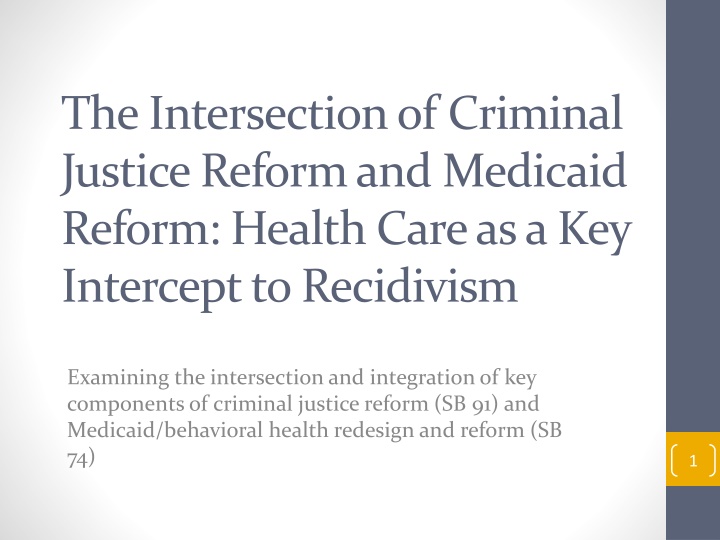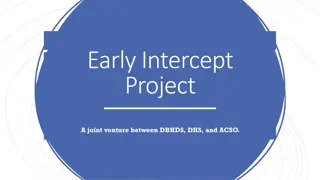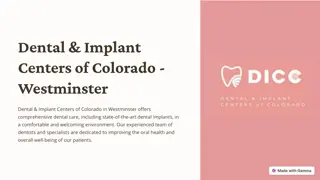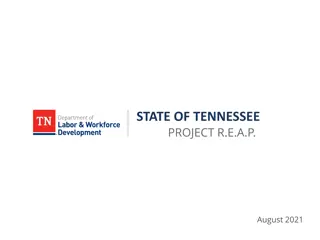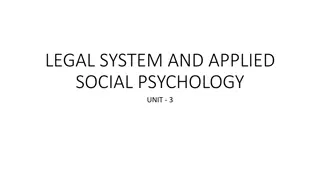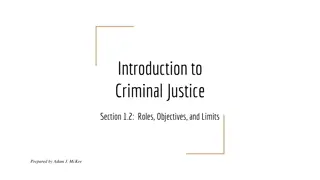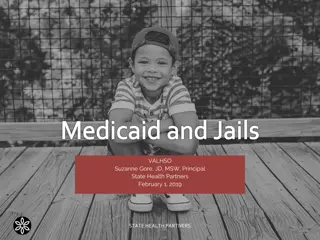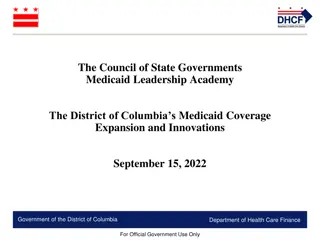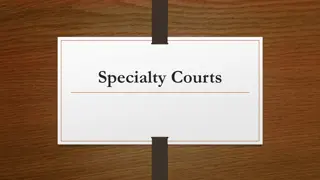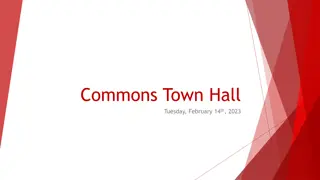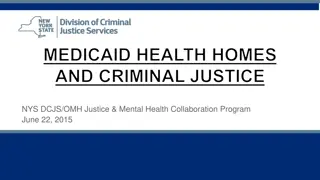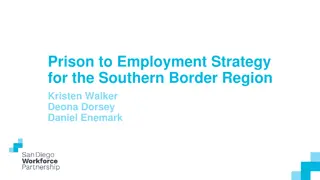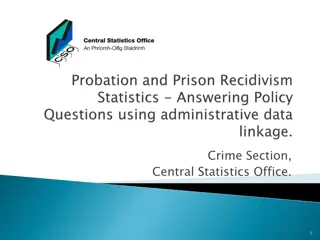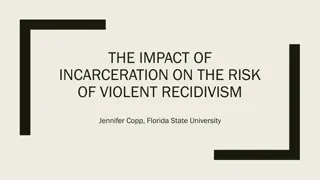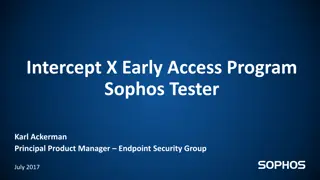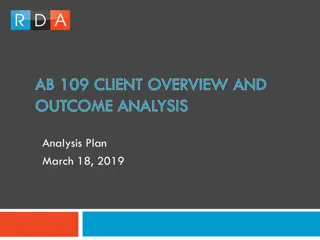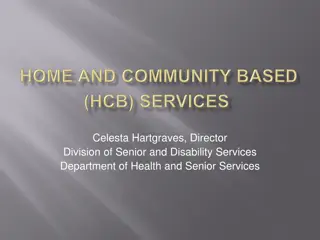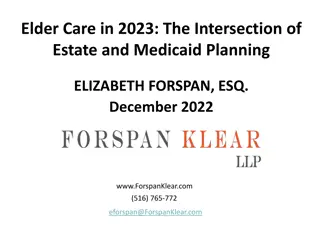The Intersection of Criminal Justice Reform and Medicaid Reform: Health Care as a Key Intercept to Recidivism
This study examines the integration of criminal justice reform (SB 91) and Medicaid/behavioral health redesign and reform (SB 74) in Alaska. It highlights the history of SB 91, the problems faced by the state's prison system, findings from data analysis, and the impact of SB 91 in reducing the inmate population through policy changes focusing on reducing felony sentence ranges, reclassifying drug possession offenses, and more.
Download Presentation

Please find below an Image/Link to download the presentation.
The content on the website is provided AS IS for your information and personal use only. It may not be sold, licensed, or shared on other websites without obtaining consent from the author.If you encounter any issues during the download, it is possible that the publisher has removed the file from their server.
You are allowed to download the files provided on this website for personal or commercial use, subject to the condition that they are used lawfully. All files are the property of their respective owners.
The content on the website is provided AS IS for your information and personal use only. It may not be sold, licensed, or shared on other websites without obtaining consent from the author.
E N D
Presentation Transcript
The Intersection of Criminal Justice Reform and Medicaid Reform: Health Care as a Key Intercept to Recidivism Examining the intersection and integration of key components of criminal justice reform (SB 91) and Medicaid/behavioral health redesign and reform (SB 74) 1
SB-91 History Statutorily Created Alaska Criminal Justice Commission (ACJC) in 2014 Inter-branch 13 member task force of state and local officials and practitioners, developed the policy foundations for S.B. 91 Technical assistance from The Pew Charitable Trust as part of the Justice Reinvestment Initiative (a partnership between Pew and the U.S. Department of Justice s Bureau of Justice Assistance) 2
Problem Presented Between 2005 and 2014, Alaska s jail and prison system population increased almost 3 times faster than the state s resident population Rapid growth and keeping prisoners in AK (instead of out of state) required building Goose Creek correctional center at a cost to the state of $240 million That was in addition to DOC s $300 million annual operating budget, which had risen 60 percent over the previous 20 years Without policy changes, the state s projected inmate population would grow by another 27 % costing another $169 million or more while the state was faces a multi- billion dollar revenue shortfall. 3
Findings The ACJC conducted an extensive data review Larger pre trial detention population - those arrested and detained while awaiting court hearings - increased by 81 % between 2005 2014 can t make bail Larger convicted and sentenced population - longer time served for felony offenses. 3/4 of newly sentenced prisoners were convicted of nonviolent offenses. On any given day in 2015, roughly 1 in 5 inmates was incarcerated for a technical violation of probation or parole conditions. 4
SB 91 In 2015 ACJC instructed by state leaders to identify policies that would cut the prison population by as much as 25 % ACJC developed 21 recommendations covering all aspects of the system S.B. 91 passed in 2016 with large bipartisan majorities in both chambers, signed into law by the governor 5
Criminal Justice Reform Reduce felony sentence ranges Reclassify drug possession offenses as misdemeanors 3, 5 and 10 day jail limits for technical violations of probation and parole Greater use of citations/summons instead of arrest Eliminate cash bail paid upfront, before release for certain pretrial defendants Create an evidence-based pretrial release system; prioritize prison space for individuals convicted of serious, violent offenses Strengthen probation and parole to reduce recidivism 6
SB 91 Outcome Criminal justice reform measures anticipated to: Avoid jail and prison population growth and reduce the number of people incarcerated by 13 percent by 2024 Save $380 million ($169 million in avoided costs and $211 million of net savings). 7
High Bar to Achieve Results Neither Alaska s criminal justice system nor our behavioral health system can conduct business as usual to deliver promised outcomes Criminal justice system must be more interested in promoting behavioral change than punishment Behavioral health must be more interested in treating those specific issues that are the drivers for criminal justice involvement 9
Justice Reinvestment Use savings from building new prison, invest those into human capital (your clients) instead Use evidence based practices to avoid their involvement in the criminal justice system Only way to decrease prison use for antisocial behaviors is to foster behavioral health and prosocial behavior 10
Justice Reinvestment If we reduce criminal justice spending we have to increase behavioral health spending Behavioral health issues and criminal thinking are the reasons why people end up in jail and prison The treatment community can t look solely to meds, money and housing with supports and a few groups as a plan calculated to prevent criminal involvement This is the new work of the treatment community and the work of Medicaid reform and redesign which is what will largely pay for this reinvestment 11
SB 91 Key Provisions of Justice Reinvestment Accompanying fiscal notes reinvest $98.8 million over six years in substance use disorder and mental health Pretrial risk assessments and supervision to counter lengthy pre trial detainment Treatment in prison and in community to counter criminogenic risk factors Re-entry supports for those leaving prison Violence prevention programming and crime victim services. This alone is not enough to do the job 12
SB 91 Criticism There is a lot of it The goal of reducing the incarceration of people with behavioral health issues that are treatable is a good one Some of the criticism of S.B. 91 fallout is not actually due the effects of S.B. 91 Whether S.B. 91 is good policy cannot be measured yet Reduction in jail time has hit a theatre near you, but the reinvestment piece is still in the pre-release stage! 14
Take away points for today: Avoiding the cost of a new prison by reducing jail use can succeed only if we reinvest the money saved into the behavioral health and other supports that allow people to change from criminal thinkers to pro social members of our community Reentry is the place for this effort 15
REENTRY occurs at both the front and back door of the jail We must find ways to collaborate at each point where your clients have interaction with the justice system to divert them away and provide evidence based treatment that will keep them away 9/10/2024 16
As if you did not have enough to do I ask you to collaborate Mental Health and Substance Use Assessment and treatment are important. Meds, money, housing must be addressed Clients involved in the justice system have many needs deserving treatment, but not all of those needs will lead to criminal behavior. For the criminally involved client, the real driver of criminal behaviors are their criminogenic risk factors Only collaborative criminal justice and behavioral health case planning to address these will prevent client involvement or re-involvement with the justice system 17
Criminogenic what factors? Criminogenic risk factors are dynamic or changeable risk factors that are measurable through assessment and contribute to the likelihood that your client will commit a crime ANY crime 18
Criminogenic Risk Factors Anti-social Attitudes (values, beliefs that reinforce criminal behavior) Delinquent Peers (criminal associates - isolation from prosocial peers) Anti-social Personality History/Pattern (impulsive, risk taking, manipulative, exploitive, aggressive, harmful toward others) Family criminality & psychological Lack of Achievement in Education/Employment Lack of Pro-social Leisure Activities Substance Abuse Most of these are no big whoop for you 19
Criminogenic Risk Factors The big whoop: antisocialism has been seen as treatment resistant Anti-social Attitudes (values, beliefs that reinforce criminal behavior) Anti-social Personality History/Pattern (impulsive, risk taking, manipulative, exploitive, aggressive, harmful toward others) 20
We are not talking about treatment resistant socio- paths They are going to use jail beds and should 21
We are talking about a thought disorder Most offenders have simply either not learned pro social behavior or learned anti-social thinking Best practice: cognitive behavioral interventions calculated to develop moral and prosocial thinking (MRT, Thinking for Change, individual therapy) We know that when people change their thoughts, they change their behaviors Referrals have to address major criminogenic needs and not just employment, housing or mental health issues 22
How to Collaborate DOC and Therapeutic Courts assess Criminogenic Risks and Needs to target drivers of criminal involvement Collaborate with DOC, Reentry Centers and the Therapeutic Courts to include these assessments in your treatment planning Offender Management Plan from DOC Reentry Center Plan Collaborate with Centers/ Coalitions Therapeutic Courts Plan Create your treatment plan with a Risk, Need and Responsivity approach And then MORE COLLABORATION 23
R(isk) N(eed) R(esponsivity) Treatment Planning(spoiler alert) Who to intervene with? High risk offenders Risk = how likely a person is to engage in criminal behavior (also called Criminogenic Risk) What to intervene with? Criminogenic needs to reduce risk Need = what areas in offenders life to target for interventions to decrease their likelihood of future criminal behavior How to intervene? Match plan to offender s ability to engage (their responsivity) Responsivity = personal strengths or challenges that affect engagement in programming 24
Review your caseload Low Risk Offender has more favorable pro-social thinking and behavior than other risk levels. Divert to voluntary programming, work units, early release / parole.
Meet the Criminogenic Needs Best practices: cognitive behavioral therapy and strategies to decrease antisocial behavior and increase pro social behaviors Provide or refer to programs that reduce the criminogenic needs/risk factors that relate to anti-social thinking are associated with reduced recidivism (MRT, Thinking for Change, etc.) Provide pro-social role modelling, refer to activities with pro social peers Every bit as important as meds, money, and housing And crucial if we hope to reduce building more prisons and seeing more of your clients in them 26
HOW Do I Do That Again? Get Risks and Needs Assessment Results Valid and Reliable Tool (DOC and Treatment Courts conduct these assessments) Don t mix low riskers with medium and highs do no harm! Program medium to high risk offenders for best results COLLABORATE DOC Offender Management Plans, Treatment Court Plans identify and address criminogenic risks and needs Identifyand factor in Responsivity Factors - Personal strengths to build on in treatment (strong family relationships, education or skills, history of stable employment, strong ties to recovery community) or challenges to overcome in order to fully participate in treatment (motivation, mental health or cognitive deficiencies, maturity, culture, transportation, etc.) 27
How Will I Know it Works? Make your plan Review and Revise Plan as indicated Collaborate with DOC, Treatment Courts near end of treatment cycle Risks and Needs decreases are measurable by RNR tool (and DOC and Treatment Courts should be reassessing) Results: Decreased Recidivism = no new prisons, increased public safety, community returning citizens with hope and a future 28 Voila.
Justice Reinvestment is a Shared Responsibility The cost of wholly punitive responses to behavioral problems is astronomical The cost to people with behavioral health issues involved in the justice system is astronomical Criminal justice and behavioral health must be close partners around our shared populations to achieve the hope of criminal justice reform Providers are the rubber that meets the road in criminal justice reform and reinvestment I invite you to get on that road and drive like the future of Alaska depends on it because it does 29
Medicaid & Behavioral Health Reform in Alaska How SB 74 will improve physical and behavioral health care across Alaska: better access, improved health outcomes and lower costs including improved outcomes for justice involved Alaskans and their families. 30
How Did SB 74 Become Law? March 2015 Senator Pete Kelly introduced SB 74 and Governor Walker introduced HB 148 & SB 78 June 2015 DHSS contracts with Agnew::Beck to develop Recommended Medicaid Redesign + Expansion Strategies for Alaska January 22, 2016 January 2016 SB 74 became the vehicle for Medicaid reform combining elements of HB 148/SB 78 and recommendations from the Agnew::Beck report SB 74 was signed into law June 21, 2016 (after much debate, dialogue, discussion and amendments) 31
Elements of SB 74 & Medicaid Reform 32
What Will Medicaid Reform Accomplish? Focus on whole person care mind, body, spirit, and environment; Move toward better integrated care physical health and behavioral health care; Coordinated, comprehensive system of care; Improved access to care when, where and what you need; Improved health outcomes with a focus on: Social determinants of health (housing, employment, life skills, social connections, physical environment) Health promotion, prevention, earlier intervention, maintenance and recovery Contained cost and increased value for every dollar spent on health/behavioral health care; Compliments and enhances Medicaid Expansion. 33
Where Do SB 91 and SB 74 Meet? Major change occurred in two different but closely aligned areas: Medicaid/health & behavioral health reform & criminal justice reform. We will: leverage pieces of each reform process to enhance and strengthen health and social service outcomes for all Alaskan s impacted by criminal justice involvement; establish clear processes, priorities and systems of care to create long-term health and wellness for individuals returning to their communities following a period of incarceration; explore ways to increase primary care and behavioral health care within our correctional institutions, through better partnerships with community-based non-profit, tribal and faith-based organizations that can provide services, through in-reach programming to inmates still incarcerated and nearing release. 35
SB 91-SB 74 Integration Initiative 6 Focus Areas: Medicaid enrollment for all eligible justice-involved individuals leaving DOC institutions (released, furlough, electronic monitoring, probation/parole) and juveniles in the custody of DJJ. SB 91 s intent is that all DOC releasing individuals will be enrolled in Medicaid (if eligible) 90-days prior to release as part of Medicaid expansion; Enhance and expand community reentry coalitions, institutional in-reach programs, reentry planning and coordination with medical, behavioral health services including updated Offender Management Plans (OMPs) and other support services such as housing, education, employment, public assistance, family support and senior-specific services for aging reentrants; 36
Focus Areas (continued) Expand services, programming and strategies to focus on needs of individuals who are charged or convicted but not incarcerated and to identify possible alternative sentencing options (such as needed behavioral health treatment), reducing unnecessary incarceration and more appropriate placement to increase successful return to community; Coordinate and align with the work of the Alaska Criminal Justice Commission s work on improving Title 12 (insanity and competency to stand trial) and Title 47 (involuntary admission for treatment and protection from self-harm or harm to others) and how it relates to use of state treatment and commitment resources; 37
Focus Areas (continued) Enhance and focus Alcohol Safety Action Programming (ASAP) screening & monitoring specifically for those individuals with alcohol-related driving arrests, including new screening tools & training in use of new tools to improve outcomes for ASAP-referred individuals; Enhance, expand and evaluate Alaska s alcohol and drug monitoring programming to increase successful alternatives to incarceration, through accessible, consistent and immediate monitoring of alcohol and drug usage, following substance-involved arrests. 38
Key Areas Where SB 91 Impacts the Work of DHSS Amends criminal statute to expand the crime of Misconduct Involving a Controlled Substance attempt to differentiate between low and high-level drug dealers. These changes apply to juveniles, referred to the Division of Juvenile Justice (DJJ); Amends criminal statute to downgrade certain criminal offenses into violations. Juveniles cited for these offenses would not be referred to DJJ; Creates opportunities for compliance with treatment plans to be an incentive to reduced sentences, including imprisonment, fine or license revocation; 39
Key Impacts of SB 91 on DHSS SB 91 removes the lifetime ban on food stamps for individuals with felony drug convictions, if conditions related to substance use treatment, recovery and rehabilitation are demonstrated. Prior to SB91, Alaska was one of seven states that continued to maintain this ban, a ban that greatly impedes the successfully reentry back into community life for former inmates; Alaska s Alcohol Safety Action Program (ASAP) will focus more specifically on alcohol/drug violations related to operating a motorized vehicle, refusal to submit to chemical testing and violating terms of probation related to substance use; allowing ASAP POs to better screen for substance use dependency and criminogenic tendencies, target referral for services, and increase monitoring of individuals engaged with ASAP; 40
Key Impact of SB 91 on DHSS Strengthens the regulations and process for programs that have, as a primary focus, rehabilitation and reduction of recidivism, especially as it relates to alcohol and drug addiction; including programs that use daily or twice daily substance testing such as the 24/7 programs; Requires DHSS to increase access to evidence-base rehabilitation programs including drug and alcohol treatment, mental health and cognitive behavioral programs; Supports offenders transition and reentry from correctional facilities to the community, including transitional housing services, employment services, vocational training, counseling and medical care; 41
Key Impacts of SB 91 on DHSS Increases focus on engaging prisoners before release, to ensure those who are eligible, are enrolled in Medicaid and other available public assistance programs upon release; Encourages increased partnerships between DOC, DHSS and community service agencies to provide in-reach programming, consultation and support. Creates the recidivism reduction fund in the general fund, supported by marijuana tax revenue, to fund recidivism programs in the departments of Corrections, Health and Social Services, and Public Safety; 42
The Bottom Line Health care and behavioral health care are inherently intertwined with criminal justice issues; Many crimes are committed due to poor physical health, mental health and addiction issues; Life-styles and environmental issues that can lead to criminality such as trauma, adverse childhood experiences (ACES), homelessness, under or un-employment, food insecurity and others also can lead to health and behavioral health concerns; Improving physical health, behavioral health and other social determinants of health WILL impact and improve crime and criminality; 43 If the ACA is repealed, Medicaid expansion will also be repealed leaving this population uncovered.
Additional Resources & Links: Alaska Criminal Justice Commission http://www.ajc.state.ak.us/alaska-criminal-justice- commission Alaska s Criminal Justice Reforms (The Pew Charitable Trusts) http://www.pewtrusts.org/~/media/assets/2016/12/alaskas _criminal_justice_reforms.pdf SAMHSA GAINS Center for Behavioral Health and Justice Transformation https://www.samhsa.gov/gains-center The Council of State Governments Justice Center The Stepping Up Initiative https://csgjusticecenter.org/mental-health/county- improvement-project/stepping-up/ 44
For further information: L. Diane Casto, MPA Behavioral Health Policy Advisor Dept. of Health & Social Services Juneau 907.465.5808 l.casto@alaska.gov The Honorable Stephanie Rhoades, J.D. District Court Judge Third Judicial District, Anchorage srhoades@akcourts.us Thank you Questions? 45
